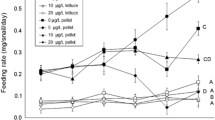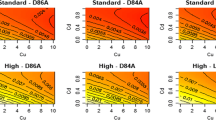Abstract
I tested the hypothesis that if sodium sulfate alters the bioenergetics of Ceriodaphnia dubia, concentrations that cause reduced fecundity in the short (7-day) and long (5 generations) term should also cause changes in feeding rate and/or metabolism, measured as oxygen consumption. In addition, to test the hypothesis that an altered bioenergetic level caused by sodium sulfate exposure will affect the response of that organism to another toxicant, I measured the acute toxicity of phenol to C. dubia in the presence and absence of both food and sodium sulfate. Sodium sulfate reduced the filter-feeding rate of C. dubia, which was associated with significantly reduced oxygen consumption. This decreased energy level appeared to result in a consistent but decreased level of fecundity over a number of generations and the reproductive impairment was dose-dependent. These effects occurred at concentrations much lower than those at which acute (mortality) effects have been observed, a finding that may have regulatory implications. In addition, whereas phenol toxicity to C. dubia was exacerbated by the addition of food, increased phenol toxicity, likely induced by an increase in filtering or metabolic rate due to food addition, was negated when sodium sulfate was added to the test medium.





Similar content being viewed by others
References
Aarset AV, Aunaas T (1990) Influence of environmental salinity on oxygen consumption and ammonia excretion of the arctic under-ice amphipod Onisimus glacialis. Mar Biol 107:9–15
American Public Health Association, American Water Works Association, Water Environment Federation (1998) Standard methods for the examination of water and wastewater, 20th edn. APHA, Washington, DC
American Society for Testing, Materials (2002a) Standard guide for conducting three-brood, renewal toxicity tests with Ceriodaphnia dubia. E1295-01. ASTM, Philadelphia, PA, USA
American Society for Testing, Materials (2002b) Standard guide for conducting acute toxicity tests on test materials with fishes, macroinvertebrates, and amphibians. E729–96. ASTM, Philadelphia, PA, USA
Arnér M, Koivisto S (1993) Effects of salinity on metabolism and life history characteristics of Daphnia magna. Hydrobiologia 259:69–77
Bridgham SD (1988) Chronic effects of 2,2’-dichlorobiphenyl on reproduction, mortality, growth and respiration of Dahnia pulicaria. Arch Environ Contam Toxicol 17:731–740
Brix KV, Volosin JS, Adams WJ, Reash RJ, Carlton RG, McIntyre DO (2001) Effects of sulfate on the acute toxicity of selenate to freshwater organisms. Environ Toxicol Chem 20:1037–1045
Correa M, Coler RA, Chih-Ming Y (1985) Changes in oxygen consumption and nitrogen metabolism in the dragonfly Somatochlora cingulata exposed to aluminum in acid waters. Hydrobiologia 121:151–156
Cowgill UM, Milazzo DP (1990) The sensitivity of two cladocerans to water quality variables: salinity and hardness. Arch Hydrobiol 120(2):185–196
Chapman PM, Bailey H, Canaria E (2000) Toxicity of total dissolved solids associated with two mine effluents to Chironomid larvae and early life stages of rainbow trout. Environ Toxicol Chem 19: 210–214
Goodfellow WL, Ausley LW, Burton DT, Denton DL, Dorn PB, Grothe DR, Heber MA, Norberg-King TJ, Rodgers JH Jr (2000) Major ion toxicity in effluents: A review with permitting recommendations. Environ Toxicol Chem 19:175–182
Gophen M (1976) Temperature dependence of food intake, ammonia excretion and respiration in Ceriodaphnia reticulata (Jurine) (Lake Kinneret, Israel). Freshwater Biol 6:451–455
Guerin Jl, Stickle WB (1992) Effects of salinity gradients on the tolerance and bioenergetics of juvenile blue crabs (Callinectes sapidus) from waters of different environmental salinities. Mar Biol 114:391–396
Hamilton MA, Russo RC, Thurston RV (1977) Trimmed Spearman-Karber method for estimating lethal concentrations in toxicity bioassays. Environ Sci Technol 11:714–719
Hansen LD, Maier KJ, Knight AW (1993) The effect of sulfate on the bioconcentration of selenate by Chironomus decorus and Daphnia magna. Arch Environ Contam Toxicol 25:72–78
Hayes JW, Stark JD, Shearer KA (2000) Development and test of a whole-lifetime foraging and bioenergetics growth model for drift-feeding brown trout. Trans Am Fish Soc 129:315–332
Kennedy AJ, Cherry DS, Currie RJ (2004) evaluation of ecologically relevant bioassays for a lotic system impacted by a coal-mine effluent, using Isonychia. Environ Monit Assess 95:37–55
Kennedy AJ, Cherry DS, Zipper CE (2005) Evaluation of ionic contribution to the toxicity of a coal-mine effluent using Ceriodaphnia dubia. Arch Environ Contam Toxicol 49:155–162
Mayzaud P, Conover RJ (1988) O:N atomic ratio as a tool to describe zooplankton metabolism. Mar Ecol Prog Ser 45:289–302
McNaught DC (1989) Functional bioassays utilizing zooplankton: a comparison. Hydrobiologia 188/189:117–121
Mount DR, Gulley DD, Hockett JR, Garrison TD, Evans JM (1997) Statistical models to predict the toxicity of major ions to Ceriodaphnia dubia, Daphnia magna, and Pimephales promelas (fathead minnows). Environ Toxicol Chem 16:2009–2019
Mourelatos S, Lacroix G (1990) In situ filtering rates of Cladocera: effect of body length, temperature, and food concentration. Limnol Oceanogr 25:1101–1111
Paquin PR, Farley K, Santore RC, Kavvadas CD, Mooney KG, Winfield RP, Wu KB, DiToro DM (2003) Metals in aquatic environments: a review of exposure, bioaccumulation, and toxicity models. Society of Environmental Toxicology and Chemistry (SETAC), Pensacola, FL, USA
Pieters BJ, Paschke A, Reynaldi S, Kraak MHS, Admiraal W, Liess M (2005) Influence of food limitation on the effects of fenvalerate pulse exposure on the life history and population growth rate of Daphnia magna. Environ Toxicol Chem 24:2254–2259
Pillai BR, Diwan AD (2002) Effects of acute salinity stress on oxygen consumption and ammonia excretion rates of the marine shrimp Metapenaeus monoceros. J Crust Biol 22(1):45–52
Richmond CE, Woodin SA (1999) Effect of salinity reduction on oxygen consumption by larval estuarine invertebrates. Mar Biol 134:259–267
Rockwood JP, Jones DS, Coler RA (1990) The effect of aluminum in soft water at low pH on oxygen consumption by the dragonfly Libellula julia Uhler. Hydrobiologia 190:55–59
Sall J, Lehman A (1996) JMP start statistics. SAS Institute, Duxbury Press, Belmont, CA, USA
Smith ME, Lazorchak JM, Herrin LE, Brewer-Swartz S, Thoeny WT (1997) A reformulated, reconstituted water for testing the freshwater amphipod, Hyalella azteca. Environ Toxicol Chem 16:1229–1233
Snow NB, Williams PJLeB (1971) A simple method to determine the O:N ratio of small marine animals. J Mar Biol Ass UK 51:105–109
Soucek DJ, Kennedy AJ (2005) Effects of hardness, chloride, and acclimation on the acute toxicity of sulfate to freshwater invertebrates. Environ Toxicol Chem 24:1204–1210
U.S. Environmental Protection Agency (2002) Methods for measuring the acute toxicity of effluents and receiving waters to freshwater and marine organisms, 5th edn. EPA 821/R-02/0122, Office of Water, Washington, DC
WEST, Inc, Gulley DD (1996) TOXSTAT® V3.5. Western Ecosystems Technology Inc, WY, USA
Acknowledgement
This study was funded in part by the U.S. Environmental Protection Agency Grant #CP96543701-0. Thanks to Alex Haldeman and Jens Sandberger of the Illinois Natural History Survey for technical assistance.
Author information
Authors and Affiliations
Corresponding author
Rights and permissions
About this article
Cite this article
Soucek, D.J. Bioenergetic effects of sodium sulfate on the freshwater crustacean, Ceriodaphnia dubia . Ecotoxicology 16, 317–325 (2007). https://doi.org/10.1007/s10646-007-0133-5
Received:
Accepted:
Published:
Issue Date:
DOI: https://doi.org/10.1007/s10646-007-0133-5




